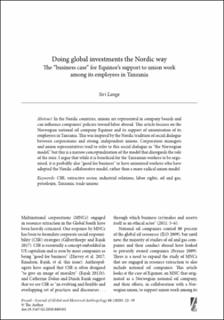| dc.contributor.author | Lange, Siri | |
| dc.date.accessioned | 2021-05-06T11:30:44Z | |
| dc.date.available | 2021-05-06T11:30:44Z | |
| dc.date.created | 2020-10-08T09:13:45Z | |
| dc.date.issued | 2020 | |
| dc.Published | Focaal: Journal of Global and Historical Anthropology. 2020, 88 22-39. | |
| dc.identifier.issn | 0920-1297 | |
| dc.identifier.uri | https://hdl.handle.net/11250/2753927 | |
| dc.description.abstract | In the Nordic countries, unions are represented in company boards and can infl uence companies’ policies toward labor abroad. Th is article focuses on the Norwegian national oil company Equinor and its support of unionization of its employees in Tanzania. Th is was inspired by the Nordic tradition of social dialogue between corporations and strong, independent unions. Corporation managers and union representatives tend to refer to this social dialogue as “the Norwegian model,” but this is a narrow conceptualization of the model that disregards the role of the state. I argue that while it is benefi cial for the Tanzanian workers to be organized, it is probably also “good for business” to have unionized workers who have adopted the Nordic collaborative model, rather than a more radical union model. | en_US |
| dc.language.iso | eng | en_US |
| dc.publisher | Berghahn | en_US |
| dc.rights | Attribution-NonCommercial-NoDerivatives 4.0 Internasjonal | * |
| dc.rights.uri | http://creativecommons.org/licenses/by-nc-nd/4.0/deed.no | * |
| dc.title | Doing global investments the Nordic way. The "business case" for Equinor’s support to union work among its employees in Tanzania | en_US |
| dc.type | Journal article | en_US |
| dc.type | Peer reviewed | en_US |
| dc.description.version | publishedVersion | en_US |
| dc.rights.holder | Copyright 2020 The Author | en_US |
| cristin.ispublished | true | |
| cristin.fulltext | original | |
| cristin.qualitycode | 1 | |
| dc.identifier.doi | https://doi.org/10.3167/fcl.2020.880102 | |
| dc.identifier.cristin | 1838098 | |
| dc.source.journal | Focaal: Journal of Global and Historical Anthropology | en_US |
| dc.source.40 | 88 | |
| dc.source.pagenumber | 22-39 | en_US |
| dc.relation.project | Norges forskningsråd: 240617 | en_US |
| dc.identifier.citation | Focaal: Journal of Global and Historical Anthropology. 2020, 88: 22–39 | en_US |
| dc.source.volume | 88 | en_US |

